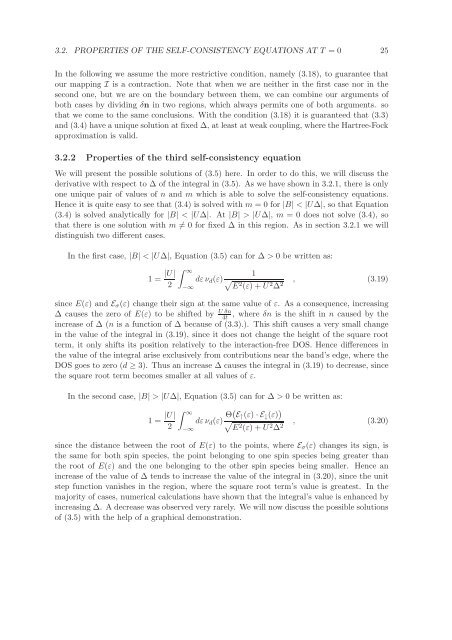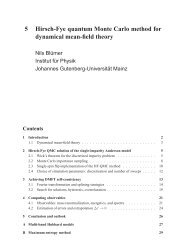Hubbard Model for Asymmetric Ultracold Fermionic ... - KOMET 337
Hubbard Model for Asymmetric Ultracold Fermionic ... - KOMET 337
Hubbard Model for Asymmetric Ultracold Fermionic ... - KOMET 337
You also want an ePaper? Increase the reach of your titles
YUMPU automatically turns print PDFs into web optimized ePapers that Google loves.
3.2. PROPERTIES OF THE SELF-CONSISTENCY EQUATIONS AT T = 0 25In the following we assume the more restrictive condition, namely (3.18), to guarantee thatour mapping I is a contraction. Note that when we are neither in the first case nor in thesecond one, but we are on the boundary between them, we can combine our arguments ofboth cases by dividing δn in two regions, which always permits one of both arguments. sothat we come to the same conclusions. With the condition (3.18) it is guaranteed that (3.3)and (3.4) have a unique solution at fixed ∆, at least at weak coupling, where the Hartree-Fockapproximation is valid.3.2.2 Properties of the third self-consistency equationWe will present the possible solutions of (3.5) here. In order to do this, we will discuss thederivative with respect to ∆ of the integral in (3.5). As we have shown in 3.2.1, there is onlyone unique pair of values of n and m which is able to solve the self-consistency equations.Hence it is quite easy to see that (3.4) is solved with m = 0 <strong>for</strong> |B| < |U∆|, so that Equation(3.4) is solved analytically <strong>for</strong> |B| < |U∆|. At |B| > |U∆|, m = 0 does not solve (3.4), sothat there is one solution with m ≠ 0 <strong>for</strong> fixed ∆ in this region. As in section 3.2.1 we willdistinguish two different cases.In the first case, |B| < |U∆|, Equation (3.5) can <strong>for</strong> ∆ > 0 be written as:1 = |U|2∫ ∞−∞1dεν d (ε) √ , (3.19)E 2 (ε) + U 2 ∆ 2since E(ε) and E σ (ε) change their sign at the same value of ε. As a consequence, increasing∆ causes the zero of E(ε) to be shifted by U δn4t, where δn is the shift in n caused by theincrease of ∆ (n is a function of ∆ because of (3.3).). This shift causes a very small changein the value of the integral in (3.19), since it does not change the height of the square rootterm, it only shifts its position relatively to the interaction-free DOS. Hence differences inthe value of the integral arise exclusively from contributions near the band’s edge, where theDOS goes to zero (d ≥ 3). Thus an increase ∆ causes the integral in (3.19) to decrease, sincethe square root term becomes smaller at all values of ε.In the second case, |B| > |U∆|, Equation (3.5) can <strong>for</strong> ∆ > 0 be written as:1 = |U|2∫ ∞−∞dεν d (ε) Θ( E ↑ (ε) · E ↓ (ε) )√E 2 (ε) + U 2 ∆ 2 , (3.20)since the distance between the root of E(ε) to the points, where E σ (ε) changes its sign, isthe same <strong>for</strong> both spin species, the point belonging to one spin species being greater thanthe root of E(ε) and the one belonging to the other spin species being smaller. Hence anincrease of the value of ∆ tends to increase the value of the integral in (3.20), since the unitstep function vanishes in the region, where the square root term’s value is greatest. In themajority of cases, numerical calculations have shown that the integral’s value is enhanced byincreasing ∆. A decrease was observed very rarely. We will now discuss the possible solutionsof (3.5) with the help of a graphical demonstration.













